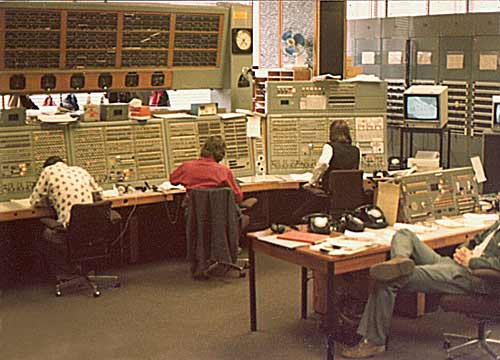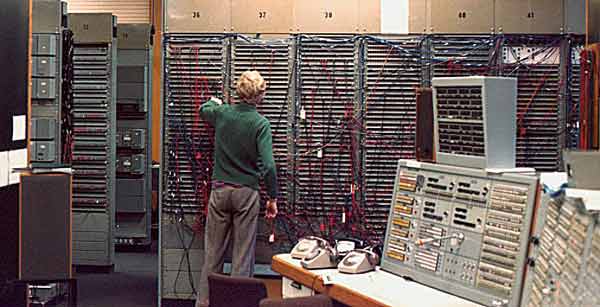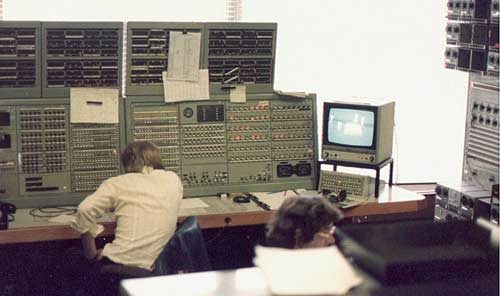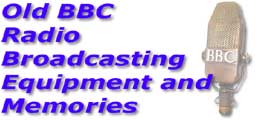
The front bench and the ATOM's desk in the late 1970s.
All change....


Nevertheless I was staff and had performed as requested, so a while later I received my "staff performance fee" cheque, complete with artists number! It was for £6.50. Apparently if I appear again in the future I will have the same number! (I've obliterated it! - RB)
If I remember correctly, the actual frequency changes were made at 23.00 that evening. - Matt Sims.
I was on duty that night, starting at 2230. The TV crew had spent the previous three days rigging the cameras and lighting for the Nationwide OB and when myself and the rest of the nightshift turned up for duty there was not one piece of the OB left in the control room, the entire thing had been derigged in three hours despite having taken three days to rig. I later discovered that the crews got the same money for derigging as rigging! - Ian Taylor.
Tea for Twenty
In earlier days than Matt's Control Room story the C&Ms were regularly manned by the most junior Technical Operators. The control positions were not far from the desk of the ATOM (Assistant Technical Operations Manager). One of the ATOMs would look at some junior TO who didn't appear to be busy and mutter the dreaded words: "It's a dry shift!". Getting no response, his utterance would get louder until it was quite obvious that we juniors could no longer pretend to be engrossed by the audio in our cans. "It's a DRY SHIFT!!!" would be the call again. You knew you would have to take the tea and coffee orders from the whole of the 20 or so people in C/R and Cons. Then go to the 8th floor restaurant and, balancing the plastic spoons (real plastic spoons in those days!) on the drinks to help the surface tension to stop them slopping over when the lift stopped on the way down to the first floor, deliver them safely to the thirsty operators. - John Hale

The main jackfield, the left hand end of the front bench in the foreground. Late 1970s.
Revenge
Rumour had it that some TOs on the SB (Simultaneous Broadcast) position were being annoyed by an engineer from one of the remote transmitters in Northern Ireland. They hatched a plan. One night shift they wheeled in a TR90 tape recorder to the SB position and set it to record at 7.5 ips. They then rang the poor unfortunate Irishman who answered the EMX with "Hallo" - which was recorded and, with head displacement delay, was fed back to him. It evidently took some while (over the poor quality control line) for him to twig that he was having a conversation with himself! - John Hale
Here are only numbers ratified
After closedown of the Third Programme at about 2330, and leaving another 20 minutes for safety so that remote transmitters would automatically power down, one poor unfortunate operator would go into the Third Programme's Continuity Studio and read out the late amendments to the nationwide line booking schedule for the following day. (No computers, remember!)
It was not unusual for some of the transmitters in fact to remain active and I can remember listening to the wonderful numbers (Manchester 386; out Birmingham 549 to London, etc) coming over my car radio on the way home from evening shift at BH as one of my night shift colleagues was doing his duty! I often wondered what Joe Public thought of these strange sounding football results! - John Hale

The TV (Sound) Switching Position. Late 1970s.
Alarm calls
Behind the C&Ms was a rest area with some chairs where TOs used to enjoy the odd cuppa or catch some shuteye overnight. At the front bench end of these seats was an LS5/8 speaker which was fed from the EMX monitoring and it normally faced the EMX operator. Nightshifts were tiring and occasionally a TO would fail to wake up - what better way to wake them than with their very own alarm...the chimes of Big Ben with the Quad amp on the 5/8 turned up full. It never failed! - Mark Smith
The Exploding Tomato
Other nightshift memories include marathon Monopoly sessions and a bizarre night when two colleagues (let's call them John and Simon) brought in some home grown tomatoes to share with A shift. This was fine until we thought it would be a good idea to conduct an experiment. John took a slightly over-ripe tomato to the 9th floor of BHX and Simon went down to the basement. The tomato was dropped down the stairwell...and probably reached its terminal velocity just before Simon tried to catch it...only it exploded all over his face! - Mark Smith
Simon owns up...
We actually ran a race starting from about the 3rd Floor, John ran up with the large, overipe tomato and I ran down to the basement. John obviously arrived at the 9th floor slightly ahead of me because as I reached the bottom of the stairs and put my hand out, I just looked up in time to attempt to catch the tomato. Unfortunately it exploded on my hand and I was showered in pips and skin! - Simon Edwards
Life's Ups and Downs
On another night shift (the same week as the tomato incident I think!) we tied another member of A Shift (Mike B.) to a chair using double enders and put him in the main BHX lift. He went up and down several times before he managed to free himself! Apparently the other passengers who saw him thought it was very funny, but did nothing to free him. - Simon Edwards
Some more memories from Simon...
Our TOM, George M., taught me how to tie a knot in a double ender using just one hand. It was a skill he had learnt to do in the old sub-basement Control Room from the balcony, using an 18ft cord! Due to the lack of a balcony I had to settle for a 6ft cord. It took me a fair few night shifts to master, but I can proudly say it is a skill I still have.
A favourite trick to play on new TOs was to plug up the EMX on the bay near the OB position, such that when one 'ring' key was thrown on OBs the entire EMX switchboard on the front bench lit up! The only way to get rid of the lights was to laboriously go through every single one and clear it which meant two or three key throws/pushes for each circuit!
Related page
They all seemed like good ideas at the time!! - Simon Edwards
Jolly Japes and Wizard Weezes
I joined the BBC in 1973 as a Technical Operator in the BH Control Room and the network radio continuities. We split work between control room duties (lines & studio switching, circuit testing and routing, transmission monitoring etc) and driving Radios I, 2, 3 and 4 (oh, and the Open University and Schools opt outs).
It was the time of the Osmonds and David Cassidy and Radio 1 was huge. The jocks were like pop stars themselves and audiences tipped 18 million at breakfast. It was an amazing time and the whole essence of Radio 1 was a 'happy' network. Producers only rarely appeared in the studio (they were too busy lunching with record pluggers) and so the T.O.s became an essential part of the production process and worked closely with the DJs.
Creating the fun on air was vital, sugar lump fights were frequent and more contrived schemes were
Related page
There was often a positive payoff to pranks, in that case editing practice, but they could turn up parts of studios and systems that were little known about. The pranks occasionally spread to the Control Room but only with care - there was a lot to break.
Sundays were often quiet, although once a month the senior bods went for 'walkies' to check over the 'D.F.' (secret emergency) stuff behind the bookcase in Duchess Street. On one occasion I was prodding around the main Control Room jackfield (ten bays of floor-to-ceiling rows of jacks connecting anything to anything and not for the faint-hearted). I came across a lonely break jack marked 'TV Monitoring'. An idea occurred.
The Tech Ops Manager that day was George Mowlam - lovely bloke but he was never too concerned with details as long as broadcasting was happening. He generally stayed in his office or wandered around smiling. The man operating the TV switching position was Alan Short (he won't mind me saying as he never forgot this incident and we laughed about it only recently). TV Switching routed audio and sync circuits from around the country to TVC - hell on a Saturday with Grandstand but not many bookings on a Sunday. Alan was watching a film on BBC2.
Hopping into an empty continuity we faded up TV sound and then while someone distracted Alan, we whacked the output of the con into that break jack. So now he was still listening to the film but it was fed via the empty Con E.
The next step was to slightly tape delay the output of the con by crossfading to a 7.5ips machine in record and plugged with a feed of TV sound. Thus the sound slipped sync with the picture. Alan spotted it right away but we were subtle and soon slid it back.
Others in on the wheeze mentioned it to Alan as it slipped wildly out. Alan was getting steamed-up and picked up the EMX phone to TVC Central Apps Room. Luckily we had thought to warn the man there to play along - he duly agreed with Alan there was a problem and offered to call the Telecine playing out the film.
And so it went on, in and out of sync until I went into the continuity studio and made a suitable apology over the top of the film, saying in my best announcer voice that we had a technical problem but would continue. Alan was cock-a-hoop and after telling TV CAR about the apology dashed into George's office to report the issue. When George checked it there, of course, all was normal.
We kept it up for a further 10 minutes but then with other work to do decided to own up. Alan would not believe us - how could it be? He had heard and seen it himself and they had apologised. It took a very long time to convince him and George had no idea what all the fuss was about anyway. I think almost everyone in the Control Room shared the laughs as did Alan in the end. It became a legendary event and I never forgot where that jack was and had to show it to many of the other guys. - Philip Hughes

